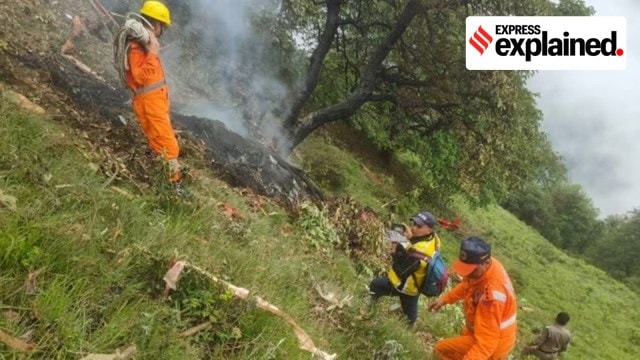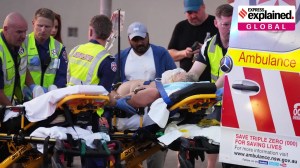Last month, five passengers and the pilot were killed after their helicopter plunged into a gorge while flying to Gangotri. On June 7, a helicopter carrying five passengers to Kedarnath had to land on a highway after a technical snag during take-off.

Helicopters being flown by private operators in Uttarakhand, specially during the Chardham pilgrimage season, were under Directorate General of Civil Aviation (DGCA) scrutiny even before Sunday’s crash. Experts say a combination of flawed policy, tricky terrain, and rapidly changing weather conditions make chopper rides in the hill state dangerous.
After June 15, all Char Dham yatra operations by Aryan Aviation, the operator of the crashed Bell 407 helicopter, have been stopped, and two other helicopter pilots, working for a different operator, have been suspended for six months for flying in “unsuitable weather conditions”.
What rules govern the private operators
While the DGCA regulates the airspace and aviation is a subject in the Union List, the Uttarakhand Civil Aviation Development Authority (UCADA), an authority instituted in 2013, coordinates with helicopter operators. Following the Sunday tragedy, questions have been raised about the absence of an Air Traffic Control system in the region
The Kedarnath helipad is located in Rudraprayag at an altitude of 11,000 feet near the shrine. The helipad is used primarily for seasonal shuttle operations during the pilgrimage, between May and June and September and October every year. The helipad is maintained by UCADA. Apart from government-owned helipads, the operators also have their own.
There are around 20 operators in the state, according to UCADA CEO Sonika, including charter services. “Charter operators can have more than two helicopters while those providing shuttle services should have at least two,” she said.
Story continues below this ad
Under the terms and conditions an operator has to follow, the UCADA mandates the following:
The fares are on par with pony rides and the royalty levied by the UCADA is Rs 5,000 per landing at government-owned helipads. This causes a race for the maximum number of sorties possible, to increase profits. Each pilot operating shuttles is permitted up to 50 landings in a day.
Additionally, the operator has to provide 10 flying hours on a non-chargeable basis each Yatra season to meet exigencies as determined by the UCADA. Failure to do so attracts a penalty of Rs 2 lakh each time.
The operators have to seek the UCADA’s permission to take breaks in flying, even during the monsoon. Withdrawal of any helicopter on the grounds of reduced pilgrim traffic is allowed only after the operator has obtained written approval of the CEO or the additional CEO of UCADA.
Story continues below this ad
The terms and conditions also say that the UCADA shall not be liable for any consequences arising out of any accident.
According to its tender documents, the upper fare is Rs 8,000 per passenger one way.
Speaking to The Indian Express, veteran aviator Cdr KP Sanjeev Kumar said a flawed revenue model could be at the root of the problems ailing the shrine tourism sector.
“In a region already loaded with capricious weather that pushes man & machine to its limits, unreasonable contractual clauses, extortionate landing charges and royalties are imposed on helicopter operators in the Char Dham region by UCADA. This incentivises unsafe flying & maintenance practices,” he said.
Story continues below this ad
Explaining further, he added, “The Char Dham flying window is already narrow, just about four months, and on top of that, authorities penalise operators for withdrawing services or grounding aircraft for maintenance. This creates pressure to fly even in adverse conditions and to maximise landings.”
Despite recommendations by the Aircraft Accident Investigation Bureau, the Kedarnath helipad still lacks navigation aids and an Air Traffic Control (ATC) facility. The operators and pilots use VHF communication (very high frequency radio waves), which can be blocked by hills and mountains.
The Kedarnath valley also lacks a meteorological facility with qualified personnel, when the unpredictable character of the weather and cloud formations makes it vital for pilots to have accurate information.
DGCA rules for Kedarnath
On Kedarnath, the DGCA has a separate annexure on the regulations. “There shall not be more than four helicopters at any given time flying within the Kedarnath valley. A maximum of six helicopters may be airborne, provided spacing is ensured in a manner so as to have only four in the Kedarnath valley. Stagger will be followed by operators to ensure only four helicopters (two inbound and two outbound) are operating within the Kedarnath valley at any one time.” On Sunday, three helicopters were en route to Guptkashi when one of them lost control.
Story continues below this ad
Also, only highly trained pilots are allowed to operate in the area. Along with the mandatory hill-flying experience, pilots operating in the Char Dham circuit should have knowledge of the terrain and minimum safe altitudes; seasonal meteorological conditions, communication and air traffic facilities; and search and rescue procedures.
How to book a helicopter for Char Dham
Most operators have direct booking through their websites. Many travel agencies provide a package that includes accommodation and transportation at an added cost.
Helicopters can be booked for all four dhams, or for just Badrinath and Kedarnath. A pilgrim goes to Gaurikund by road, which is the base station and 16 km away from Kedarnath shrine. From here, a mule or a pony for the road ahead takes hours, while a helicopter takes 15 minutes.
Recent aviation accidents in Uttarakhand
May 8, 2025: Six dead near Gangotri.
Story continues below this ad
April 2024: An Uttarakhand government official was killed after being hit by the moving tail rotor blade of a helicopter he was about to board in Kedarnath, two days before the portals of the shrine were to be opened for pilgrims.
October 2022: All seven people, including the pilot, onboard an Aryan Aviation helicopter carrying Kedarnath pilgrims were killed as it crashed after colliding with a hill amid low visibility in Rudraprayag district.
August 2019: Three people were killed when a helicopter engaged in rescue operations in cloudburst-hit areas of Uttarkashi district crashed at Moldi village in Arakot. The helicopter was owned by Heritage Aviation.
June 2017: A helicopter engineer in Badrinath died while two pilots suffered injuries after the chopper met with an accident. The Agusta 119 helicopter, belonging to Kestrel Aviation, was on its way to Haridwar, carrying five pilgrims, along with the two pilots and one engineer.








































